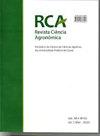Occurrence and spatial distribution of native acai groves in high-production areas of the Amazon region
IF 0.7
4区 农林科学
Q3 AGRICULTURE, MULTIDISCIPLINARY
引用次数: 0
Abstract
- The fl oodplain forests of the Amazon estuary have undergone constant change over recent years, where management techniques, especially intensive management, have had an impact on the dynamics of the vegetation and land use. These changes can be monitored using satellite data. With this in mind, the aim of this study was to evaluate the dynamics of ground vegetation on the islands of Jarimbu, Mamangal, Itaboca, Mutirão and Buçu in the district of Igarapé-Miri, Pará, using images from the RapidEye and Planet satellites. The unsupervised ISODATA classi fi cation method was used, generating distinct classes of vegetation between each island. To evaluate the e ffi ciency of the classi fi cation, an average of 200 random points were used, with another 30 points relating to the type of usage for each class. The Kappa index and overall precision were also analysed, in addition to calculating errors of omission and commission. Monitoring on a seven-year time scale using high-resolution satellites, a more than 50% increase in the Exposed Soil class was seen for the islands of Jarimbu, Mutirão and Itaboca, the latter responsible for an increase of more than 50% in the Urban Area class. On each of the fi ve islands, the Alluvial class, representing the areas of açaí groves, has emerged over the last seven years, increasing in area at the expense of a reduction in the Arboreal class. In this respect, the confusion matrix showed a mean accuracy for the islands of ‘very good’, with a mean overall precision of 77.74%, and a mean Kappa index of 0.73, indicating strong agreement with the reference data and the classi fi cation亚马逊地区巴西莓高产地区原生巴西莓林的发生与空间分布
本文章由计算机程序翻译,如有差异,请以英文原文为准。
求助全文
约1分钟内获得全文
求助全文
来源期刊

Revista Ciencia Agronomica
Agricultural and Biological Sciences-Horticulture
CiteScore
2.00
自引率
0.00%
发文量
41
审稿时长
4-8 weeks
期刊介绍:
To publish technical-scientific articles and study cases (original projects) that are not submitted to other journals, involving new researches and technologies in fields related to Agrarian Sciences. Articles concerning routine analysis, preliminary studies, technical notes and those which merely report laboratorial analysis employing traditional methodology will not be accepted for publication. The Journal of Agronomical Science also has the mission to promote the exchange of experience in the referred fields.
 求助内容:
求助内容: 应助结果提醒方式:
应助结果提醒方式:


